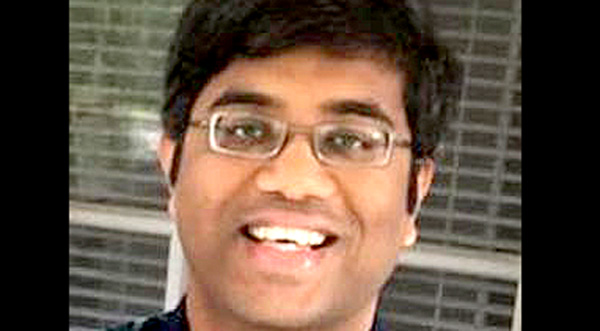Astrobiologist Manasvi Lingam of Florida Tech is researching the probability of the emergence of life on Earth
Researchers modelled three different scenarios

BREVARD COUNTY • MELBOURNE, FLORIDA – Florida Tech astrobiologist Manasvi Lingam started asking life’s biggest questions at a young age. Although he can’t remember his exact questions, he says his interests were completely in line with those of other kids: dinosaurs and aliens.
On bus rides with his family, he bombarded his parents with questions about the mysteries of the universe. On long walks with his grandfather, he wondered how life could exist on different planets.
Lingam’s fascination with early life and astrobiology never waned. Now an assistant professor of astrobiology, he has moved from asking questions of his grandfather to creating his own models to explore complex topics like the origin of life. He traded the pursuit of definitive answers for scientific conclusions and accounted for the uncertainties of the universe by exploring chance.
According to Lingam, models – simplified representations of reality – serve two main purposes: they help researchers make predictions and they provide an alternative to experiments that may be too expensive or impractical. This was also the case with Lingam’s recently published analysis of the possible origin of life on Earth.
“A Bayesian analysis of the probability of life arising per site conducive to abiogenesis,” published August 19 in the journal Astrobiology by Lingam, recent Florida Tech graduate Ruth Nichols and astrobiologist Amedeo Balbi of the University of Rome, models the relationship between hypotheses that predict different numbers of potential sites for abiogenesis – the emergence of life from nonlife – on Earth and the probability of life arising at those sites.
A Bayesian analysis uses prior knowledge to estimate posterior probability. For this model, researchers focused on the possibility that life arose on Earth itself. So, since it is certain that there is life on Earth, this model assumes that life arose on Earth at least once.
Lingam says this is one of his first times looking specifically at the origin of life, but he has also modeled several related questions, such as the evolution of technology-based intelligence.
The researchers compiled potentially habitable sites – places where life could emerge – that they had identified in previous research. Each site was suitable for the emergence of life to varying degrees. They included several different environments, from underwater volcanoes to soap bubbles and tar to natural nuclear reactors like one that formed in Gabon two billion years ago.
Their models were based on two main questions: how many places on Earth could life have evolved, and what is the probability that life actually evolved in one of those places? The goal of the study was not to answer these questions directly, but to find the most accurate way to interpret the data generated by the models.

The researchers modeled three different scenarios: one with 10 walkable locations, one with 1031 (that’s 10 million trillion trillion, or a 1 followed by 31 zeros) walkable locations, and one near the middle with 1016 walkable locations.
Lingam initially assumed that access to a greater number of exploitable sites would increase the likelihood of life arising on Earth. Remember, the more lottery tickets you buy, the more chances you’ll have of winning.
Instead, the results in this agnostic scenario were just the opposite. Lingam found that when comparing the larger number of sites to the smaller number, the probability of life per pool was almost inversely proportional to the number of pools.
“Those are the two situations we have here. In one, there are many sites, but the probability (of life) per site is very low. And in the second, there are very few sites, but the probability per site is very high,” says Lingam.
Yes, this result is counterintuitive, he says. That’s why it’s important.
“Usually, the attitude for many things in life is ‘the more the better,'” says Lingam. “But more is not always better. If it’s less, but the right kind of less, then that can actually be better.”
In other words, in the model where there are fewer walkable sites overall on Earth, the researchers concluded that the probability of life arising at a given site is higher. They concluded that a greater chance of life arising is more likely when walkable sites are rare, and that a large number of walkable sites could reduce the probability of life at a given site.
They concluded that the smaller sample of sites, which had a higher probability of life at a particular location, probably provided more favorable environments.
Their findings suggest that setting constraints on the availability of suitable environments for the origin of life on Earth within the Bayesian framework can provide valuable insights into the probability of abiogenesis and the abundance of life elsewhere in the universe.
How could these findings be used?
Because researchers disagree about which environments are most likely to support life, Lingam says they can use this model to understand their preferred environments.
“Then they can do lab experiments and try to get a sense of how many attempts it might take to actually transition to something life-like,” Lingam says.
Lingam also hopes to further deepen his understanding of early life by exploring the origins of intelligence.
While he may not be able to directly answer the questions of his childhood, Lingam accepts the limitations and uncertainties that come with his models.
“We can’t look into the past,” says Lingam. “Sometimes you can get answers just by cleverly using limited data… but there’s a part you’ll never know.”
From his curiosity-driven upbringing to his flourishing career in astrobiology, Lingam has remained devoted to the wonders that have always fascinated him.
“I think this is something every child goes through, but I took it very seriously,” says Lingam. “It feels like I’m returning to that childhood path after a long, winding journey.”
CLICK HERE FOR BREVARD COUNTY NEWS





